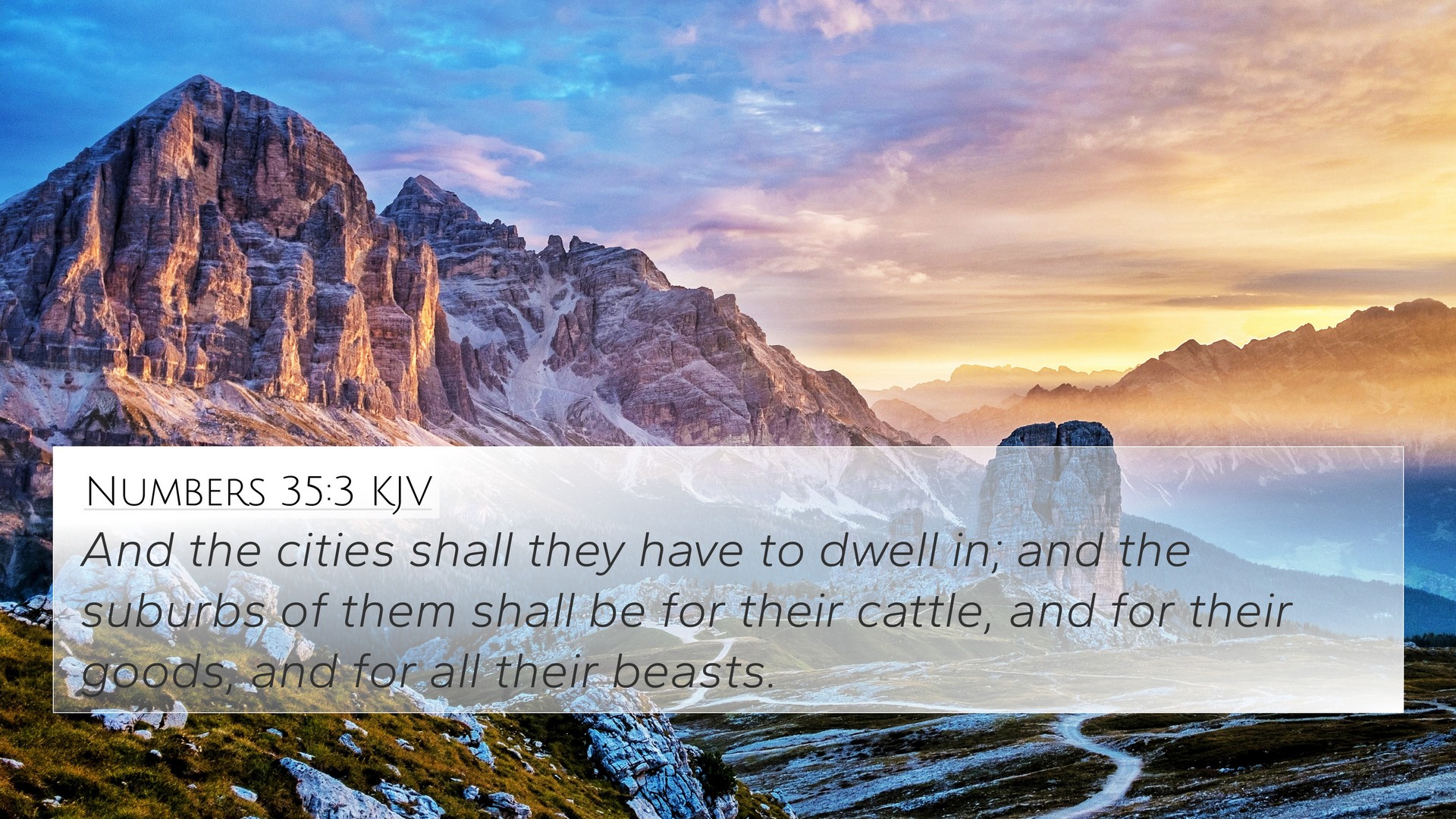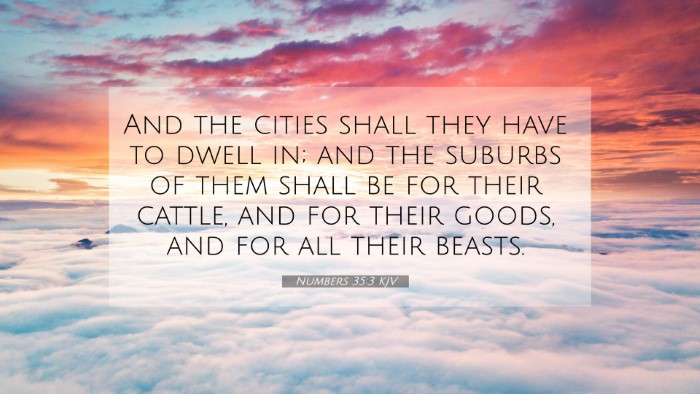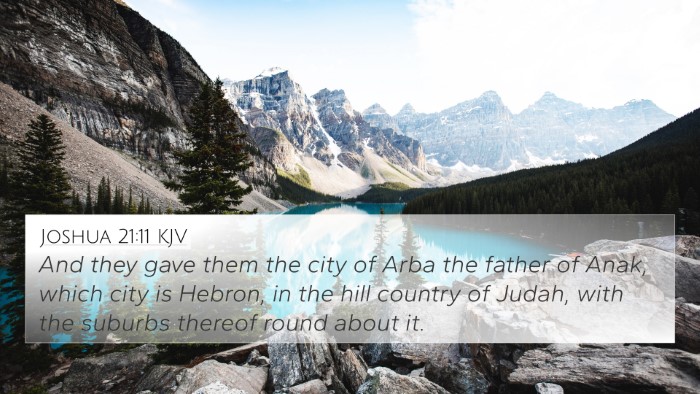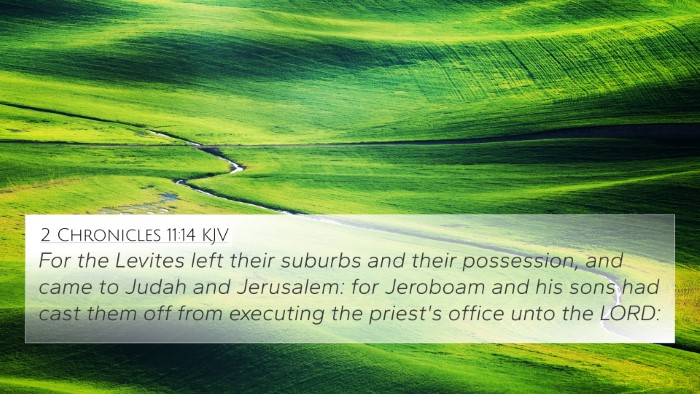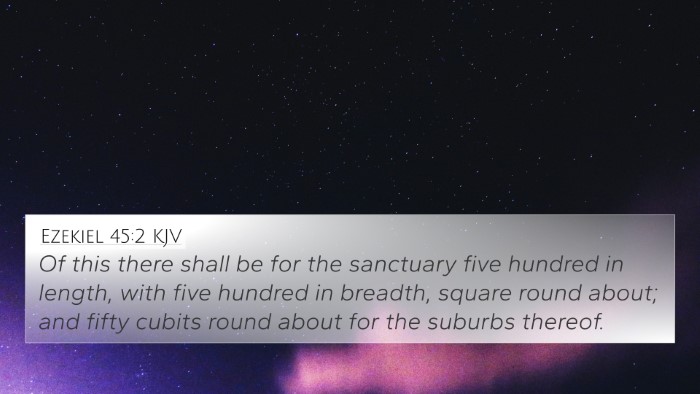Understanding Numbers 35:3
Verse: Numbers 35:3 states, "And the cities shall they have to dwell in; and the suburbs of them shall be for their cattle, and for their goods, and for all their beasts." This verse is part of God's instruction regarding the cities of refuge and the allocation of land for the Levites.
Contextual Overview
The Book of Numbers details the Israelites' journey in the wilderness, including laws and regulations set forth by God. Numbers 35 specifically discusses the establishment of cities of refuge, showcasing God’s mercy and justice. This chapter explicitly illustrates God’s concern for the Levites, who were set apart for religious duties and had no inheritance among the tribes.
Commentary Insights
- Matthew Henry: Henry emphasizes the significance of the Levites' cities and their surrounding land. He notes that these cities served both as places of refuge and as a means for the Levites to support themselves. The allocation of land reflects God’s providential care.
- Albert Barnes: Barnes highlights the functional purpose of the suburbs that provided the Levites with land for their livestock and possessions. This allocation ensured their livelihood, as they were dedicated to the service of God and had no land of their own.
- Adam Clarke: Clarke points out the importance of the cities of refuge in protecting those who accidentally committed manslaughter. He stresses that these cities symbolize God's mercy and the system of justice that is integral to the community life of Israel.
Thematic Analysis
Numerous themes converge in this verse, including
- Divine Provision: The assignment of cities demonstrates God's provision for the Levites, ensuring their needs are met amidst their service.
- Justice and Mercy: The cities of refuge signify the balance between justice for the victims and mercy for the perpetrators of unintentional harm.
- Community and Responsibility: The system illustrates the communal responsibility of the Israelites to care for the Levites, reinforcing their role within the larger community.
Bible Verse Cross-References
To deepen your understanding of Numbers 35:3, consider the following Bible verses that connect with its themes:
- Leviticus 25:32-34 - Discusses the rights of the Levites regarding the property in the cities.
- Deuteronomy 19:1-13 - Outlines the cities of refuge and their purpose in protecting those who committed manslaughter.
- Joshua 21:1-42 - Details the allocation of cities for the Levites among the Israelite tribes.
- Hebrews 6:18-20 - Reflects on God as a refuge, symbolizing hope and safety in Christ.
- 1 Chronicles 6:54-81 - Lists the cities that were given to the Levites as their inheritance.
- Numbers 35:6 - Further delineates the geographic distribution of these cities of refuge.
- Psalm 46:1 - Similar themes of God being a refuge and help in times of trouble.
Connections Between Bible Verses
Examining the connections between these verses not only enriches our understanding of the context but serves to illuminate the interconnectedness of scriptural themes. For example, the laws about cities of refuge in Numbers and Deuteronomy reflect God’s desires for justice tempered with mercy, a theme that threads through both Testaments.
Inter-Biblical Dialogue
The establishment of cities of refuge introduces an early portrayal of justice that is reflected in New Testament teachings. In the teachings of Jesus, mercy and justice are crucial elements, particularly in parables that emphasize forgiveness and redemption. This inter-Biblical dialogue highlights God’s holistic approach to justice throughout scripture.
How to Use Bible Cross-References
Cross-referencing Bible texts enables readers to:
- Discover thematic connections across scripture.
- Understand the historical and cultural contexts of verses.
- Explore the progression of biblical themes, such as justice, mercy, and divine provision.
- Enhance personal Bible study by linking related passages for a comprehensive understanding.
Bible Reference Resources
For effective Bible study, you can utilize various tools:
- Bible concordances for identifying key themes.
- Cross-reference guides to navigate connections between verses.
- Applications and studies focusing on thematic Bible verse connections.
- Online platforms offering comprehensive Bible cross-reference materials.
Conclusion
Numbers 35:3 offers insight into God's provision and the justice system intended for the Israelites. Understanding this verse's meaning and its connections with other scriptures deepens our appreciation of the Bible’s unified narrative. By using tools for Bible cross-referencing, readers can explore the rich tapestry of connections that exist within the sacred text.
